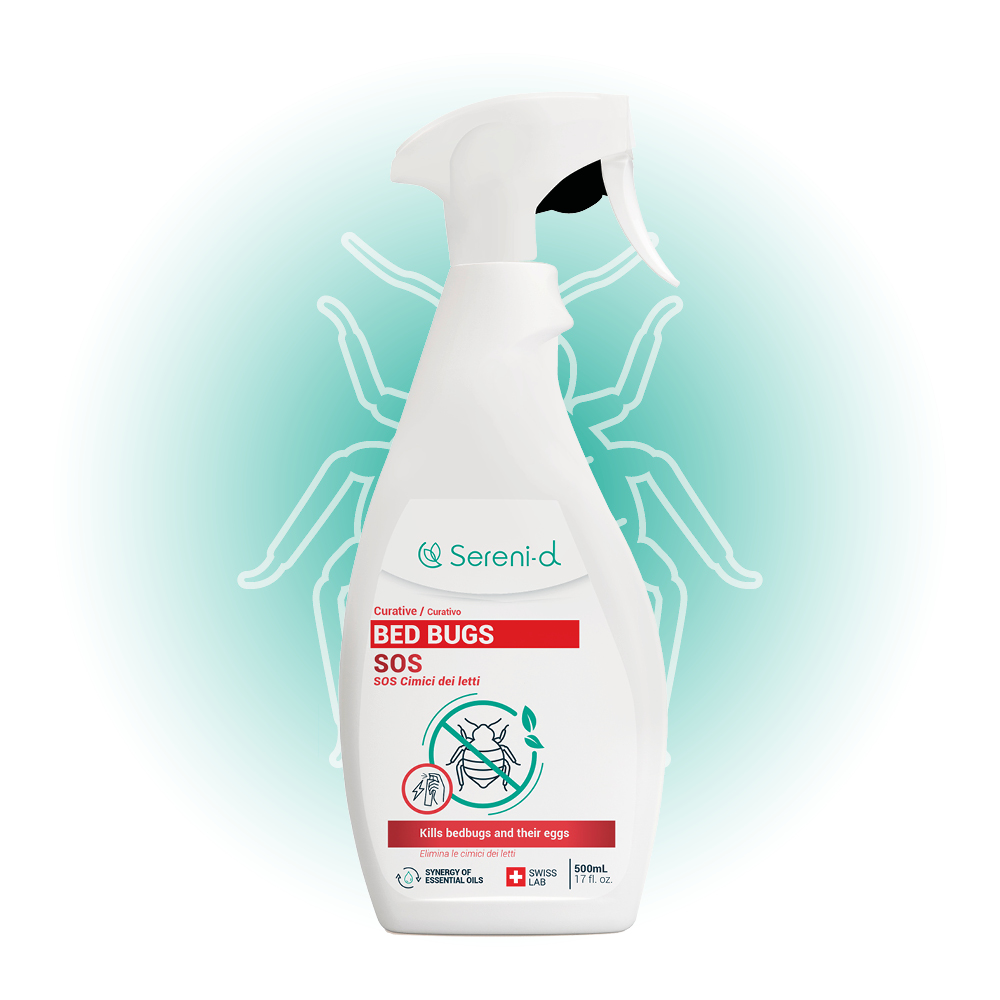Bedbugs are currently on the increase, whether in our homes, in tourist establishments or in places open to the public (nurseries, cinemas, etc.). So how do you recognise bedbugs and get rid of them ?
Treatments: how do you get rid of bedbugs?
There are several treatments available to get rid of bedbugs: natural treatments or, conversely, chemical treatments. Whatever treatment is used, it should be complemented by a thorough clean of every part of the affected room. Here are all the solutions you need to get rid of these pests.
Natural treatments: how do you eliminate bedbugs naturally?
Natural solutions include natural insecticides, baking soda, diatomaceous earth, essential oils and bedbug traps and covers.
- Natural insecticides
Natural insecticides are an effective solution for controlling bedbugs, while protecting the health of people living in infested homes. With this in mind, Sereni-d has developed the Natural SOS Bedbugs treatment that eliminates 100% of bedbugs, while being FREE of synthetic permethrin, DEET, flammable propellants and endocrine disruptors. This ready-to-use spray contains plant pyrethrum flower extract combined with a complex of essential oils with insecticidal properties. Once sprayed, it neutralises, intoxicates and dries out bedbugs present on the treated surface. Its effectiveness is immediate and long-lasting, lasting up to 12 days in optimal conditions of use.
- Other natural insecticide: Diatomaceous Earth
Diatomaceous earth can be used as a repellent and insecticide. Originally made from microalgae, diatomaceous earth, sold in powder form, is effective against bedbugs. But use with care. Although not toxic to humans or animals, diatomaceous earth is irritating to the eyes and respiratory tract in particular. Diatomaceous earth is sprayed onto infected surfaces, freezing bedbugs as they stick to the product.
Find out all you need to know how to use Diatomaceous Earth on bedbugs in our specialised article.
- Baking soda treatment
Baking soda is another natural solution for getting rid of bedbugs. It can be used in powder form or diluted in water. This natural treatment, which is harmless to humans, is lethal to bedbugs. In fact, it causes intense irritation in bedbugs, which end up dying of dehydration. When used as a powder, simply sprinkle on infected surfaces and leave for a few days before vacuuming up. Baking soda can also be diluted in water and sprayed into every nook and cranny of the room to be treated.

100% natural insecticide
SOS Anti-Bedbugs treatment
SOS Bedbug Repellent Treatment is a natural insecticide effective against bedbugs for immediate, safe and long-lasting protection.
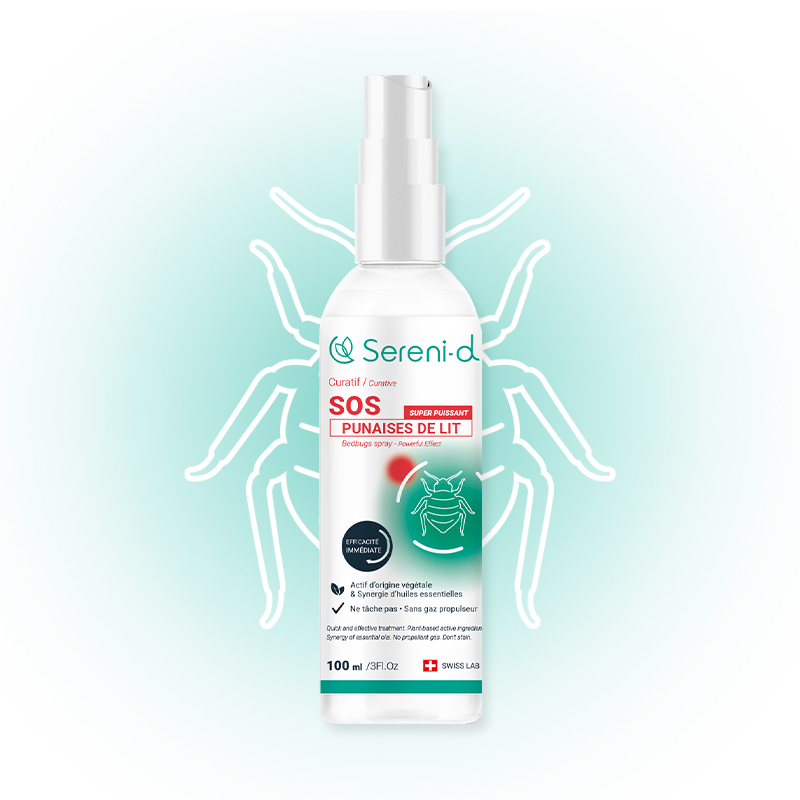
- Eliminates 100% of bedbugs
- Pyrethrum flower extract and essential oil synergy blend
- Does not stain
- Pleasant fragrance
€24.90
- Anti-bedbug essential oils
Essential oils that are effective against bedbugs include Lavender Aspic EO, Tea Tree EO, Java Lemongrass EO and Clove EO. Lavender Aspic essential oil has anti-parasitic and insecticidal properties. Tea Tree essential oil also has anti-parasite and repellent properties. Java citronella essential oil is a repellent, anti-parasite and insecticide. Finally, clove essential oil acts as an insecticide. Take care, however, to use the correct dosage, and ask your pharmacist for advice if you have any doubts about use.
- Anti-bedbug covers
To avoid bedbugs, you can also buy special anti-bedbug covers. These sealed covers protect and form a protective barrier against parasites. Anti-bedbug covers come in the form of mattress, pillow and bedbase covers. For more information, don’t hesitate to check out our article on bedbugs in mattresses: inspection and processing.
- Bedbug traps
All kinds of bedbug traps are available. There are 3 main categories of traps: attractive sticky traps, interceptor traps and detector traps.
sticky attractant traps contain a nutritive or hormonal substance (pheromones) which attracts bedbugs and neutralises them with an adhesive base (sticky or glue). Once trapped in the sticky case, these insects cannot escape and die within 48 hours. The only drawback is that you have to place numerous traps in the room to be treated, and keep replacing them.
Another category of anti-bedbug trap: interceptor traps. These traps don’t use any products to kill bedbugs. They come in the form of domes to be placed under each footboard. Their specific shape captures bedbugs as they climb in and out of bed, trapping them inside.
Detector traps can be used to detect the presence of bedbugs in the home. This type of trap attracts bedbugs and allows you to monitor whether they are still present. Carbon dioxide traps are the most common. Bedbugs are attracted by CO2 and come out of their hiding place.
Find out more in our article on bedbug traps: efficiency, instructions for use, home-made traps.


How do you treat bedbugs chemically?
There are many chemical products on the market, some of which can be used by private individuals, while others are reserved for professionals.
Over-the-counter chemical bedbug repellents often include Improthrin- and Cypermethrin-based products. These are active substances that act on parasites through direct contact. Most of these products remain active for 3 months. They must be used with great care, as their composition is irritating and highly toxic to aquatic organisms.
Chemical products against bedbugs come in different forms: smoke bombs, sprays, bedbug tablets, impact insecticides, growth regulators…
Finally, if you need to use chemical insecticides, make sure you follow the application recommendations. Some products can cause poisoning, so avoid using them if you are at risk (pregnant women, babies, the elderly…).
Professional treatments against bedbugs
When the bedbug infestation becomes unmanageable, , you can call on a pest control company. Generally speaking, the professional protocol consists of chemically disinsecting the dwelling with 1 to 3 rounds of biocidal treatment at 15-day intervals. The treatment can involve low-pressure spray, atomisation or fumigation.
Another solution proposed by professionals: steam treatment (180°C) or cold treatment (-17°C). Bedbugs die as a result of a thermal shock. Please note: Steam treatment is more effective than cold treatment, which can take longer to eradicate bedbugs.
Professionals can also use canine detection to accurately identify where bedbugs are hiding and then apply the treatment in the right place for a better success rate.
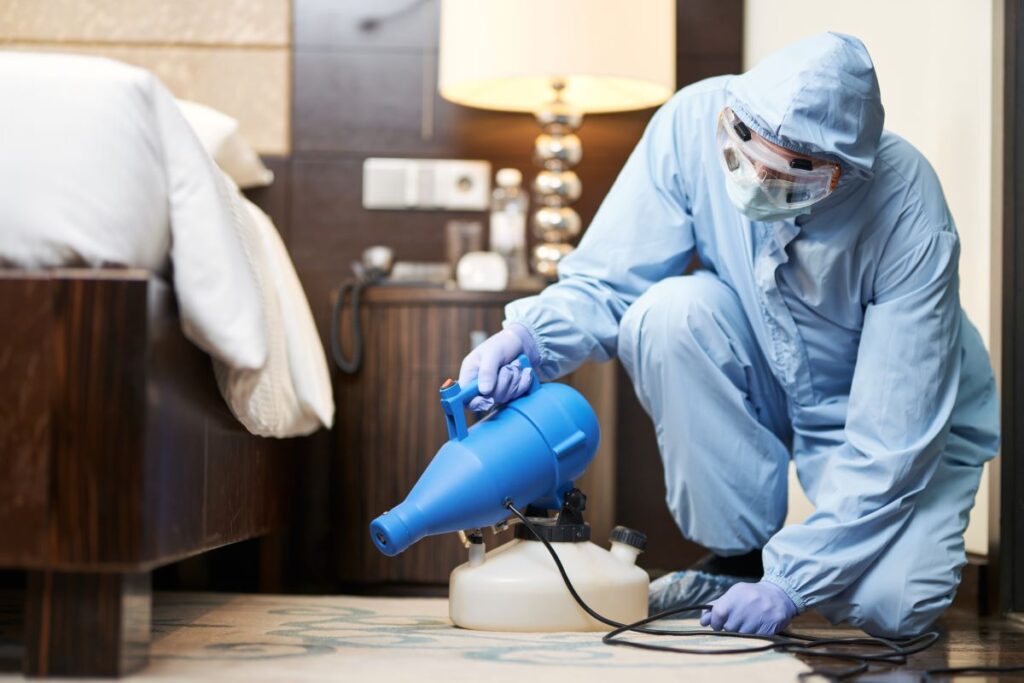

How do you kill bedbugs for good?
In addition to a bedbug treatment, whether natural or chemical, it’s imperative to thoroughly clean the bedbug-infested room. Here are the various tasks to be carried out to get rid of bedbugs:
- Vacuum cleaner: Vacuum up all bedbugs visible to the naked eye, and empty the vacuum cleaner when finished to prevent bedbugs from spreading.
- Steam cleaner, vaporetto, karcher: steam burns bedbug eggs and adult bedbugs. A steam cleaner or karcher is ideal for killing pests hiding in cracks and crevices. Steam is one of the best and most environmentally-friendly ways to kill bedbugs.
- Wash at 60°C or freeze: wash all the linen in the room that can be cleaned at 60°C and put the rest in the freezer to eliminate any bedbugs.
- Tumble dry for 30 min on high heat
- Potential treatment on the building: cracks and crevices are ideal hiding places for bedbugs. If you notice any cracks in the walls, fill them in.
Signs and symptoms: how do you know if you have bedbugs?
There are certain signs that indicate the presence of bedbugs in the home. Here’s where bedbugs usually hide, how to recognise them and how to spot their bites.
Where bedbugs hide ?
Bedbugs prefer dark, narrow and inaccessible places. They generally establish themselves in bedrooms. They can be found on bed bases, mattresses, headboards, bed frames, pillows and sheets. They also like to nestle in nooks and crannies, skirting boards, wallpaper and cracks, or behind pictures and frames. They can be found in carpets, rugs, sofas, chairs, furniture (wardrobes, dressing rooms), on clothes…
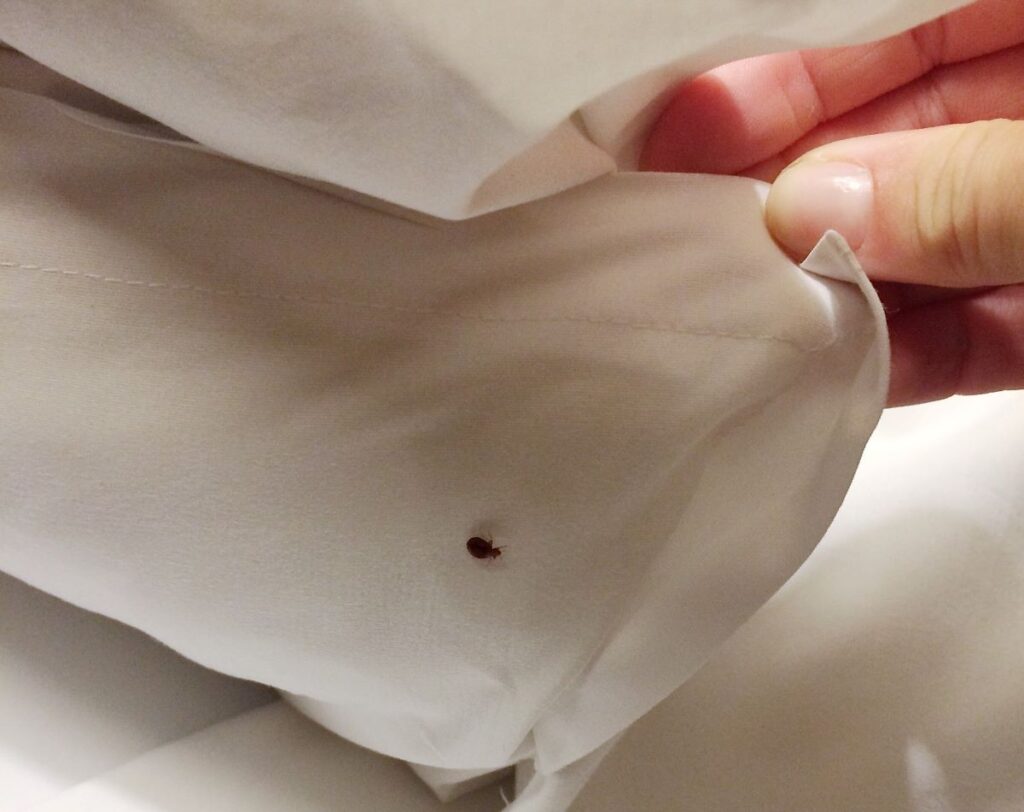
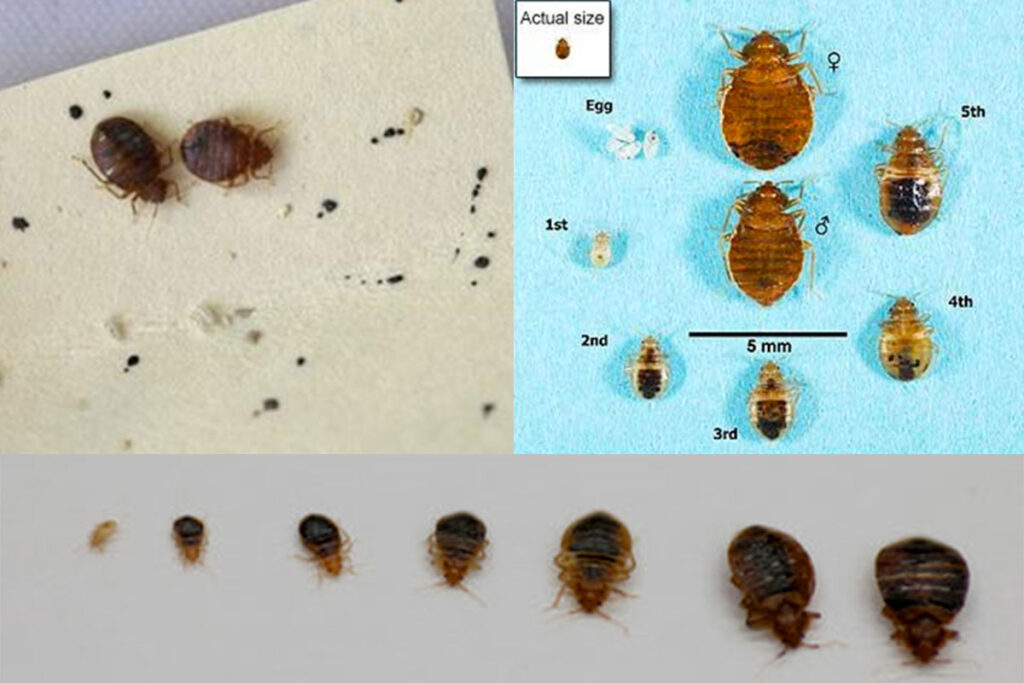
How to recognise a bedbug
Adult bedbugs can be spotted with the naked eye. They are between 4 and 7 mm long, brown in colour and look like a flattened apple seed when gorged with blood. Thanks to its flat, oval shape, it will slip in just about anywhere. It doesn’t jump or fly. It comes out at night to feed and generally hides during the day. They have a lifespan of 5 to 6 months and reproduce rapidly.
Bedbug eggs are oval, cream, yellowish or whitish in colour, and 0.5 mm to 1 mm long. Bedbug eggs are generally arranged in clusters and fixed in small nooks and crannies. The eggs hatch after 10 to 14 days.
The larvae are flattened and oval, 1 to 2 mm long and translucent brown in colour. Bedbugs are haematophagous insects, i.e. they feed exclusively on human blood.
Baby bed bugs
Baby bed bugs, known as nymphs, are the juvenile stages of these insects before they reach adulthood. Very small, measuring around 1 to 2 mm, they are almost transparent, making them difficult to spot, especially in the early stages of an infestation. As they grow, the nymphs go through five stages of development, and must feed on blood between each moult to continue their growth. Unlike adults, which turn a reddish-brown colour after feeding, nymphs turn bright red, which can make them slightly more visible on light surfaces.
Treating the appearance of baby bed bugs requires a methodical approach, as these young nymphs are difficult to spot and can hide in the smallest nooks and crannies.
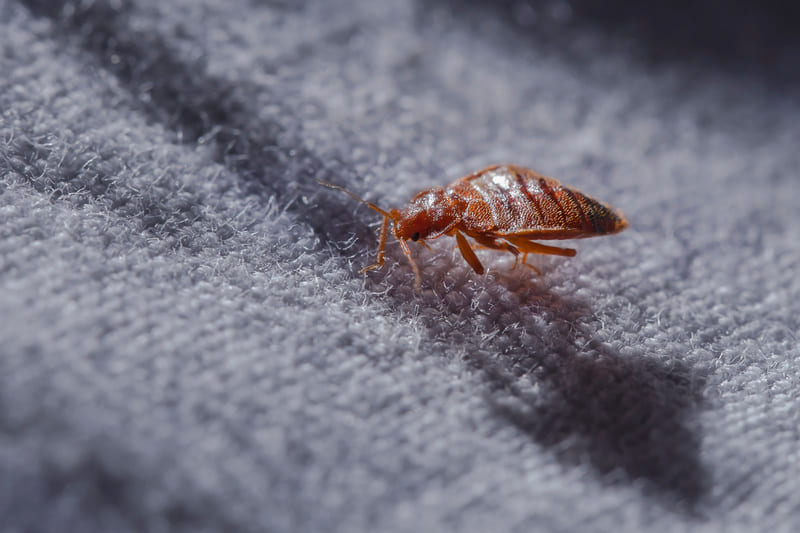
How to detect the presence of bedbugs?
Bedbugs can be found with the naked eye for adult-sized bugs. If you are infested, there are several warning signs: blood stains on the sheets, excrement, empty shells or a sweet, unpleasant smell and, of course, the appearance of bedbug bites on your skin.
Bloodstains on the sheets: indeed, bedbugs feed on blood. Once gorged with blood, it’s not uncommon for bedbugs to be crushed while you sleep, leaving small traces of blood on our sheets.
Excrement: you can find their excrement that looks like small black dots. They can be found on walls, bed frames, mattress seams, sheets and pillows.
Empty shells: bedbugs moult as they develop. The moulted skin resembles small, empty, transparent shells. They can be found near places where bedbugs hide.
A sweet, unpleasant smell: the presence of an odour often described as a strong ammonia smell can also point to the presence of bedbugs.
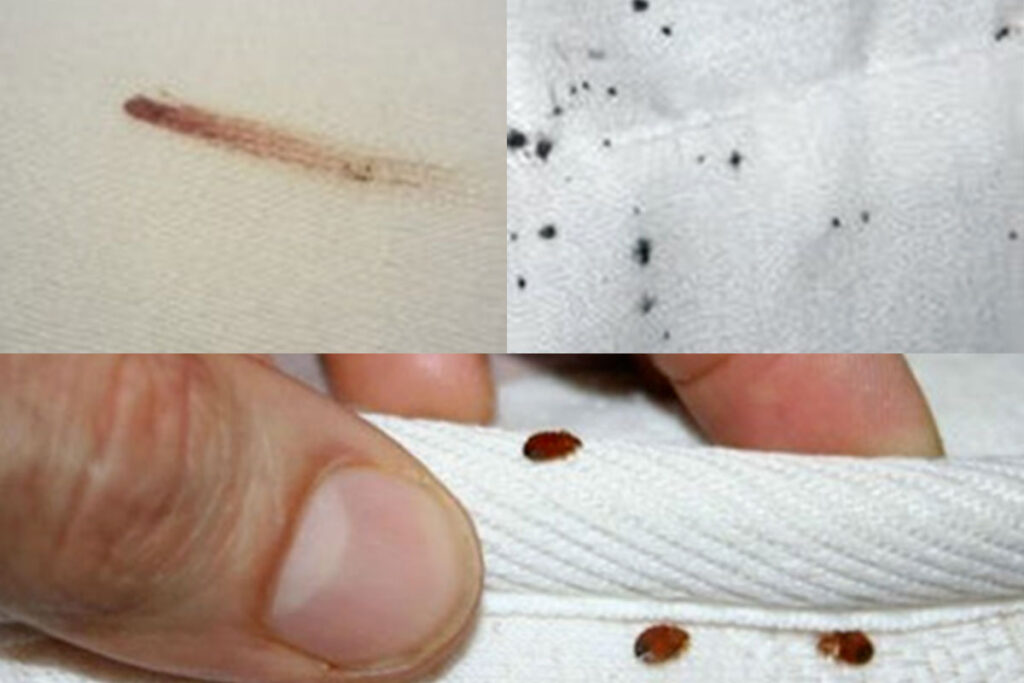

How to recognise bedbug bites
Bedbug bites are similar to mosquito bites, they form small red marks or spots on the skin that can be itchy.
The bites are frequently aligned or grouped, and are located on certain parts of the body such as the arms, legs and back.
A person can be stung 50 to 90 times in a single night. By the time you start to get bitten, the infestation is usually already well advanced. The spots may itch for 3 to 10 days, depending on the skin.
To find out more, view how to recognise and treat bedbug bites.
How do you treat rashes caused by bedbug bites?
Bedbug bites are not generally dangerous to health, but some people can suffer allergic reactions.
If spots cause itching, apply a soothing lotion. Sereni-d has created the Anti-Bite Roll-On made from a 100% pure and natural organic essential oil synergy blend. Its soothing action immediately calms itching. Healing is accelerated thanks to its antiseptic, anti-inflammatory and healing properties. Sereni-d Roll-On Bedbug Repellent can also be used for prevention, thanks to the repellent properties of its oils. Before and after bedbug bites, this Roll-on can be taken with you wherever you go.
Finally, an estimated 30% to 40% of people are allergic to bedbug bites. Symptoms of an allergic reaction to bedbug bites include itching, redness and swelling around the bitten area. In this case, ask your doctor for advice.
100% natural solution
Anti-Bite Roll-On
Sereni-d Roll-On Anti-Bite immediately relieves itching and repels bedbugs thanks to its essential oils with repellent properties.
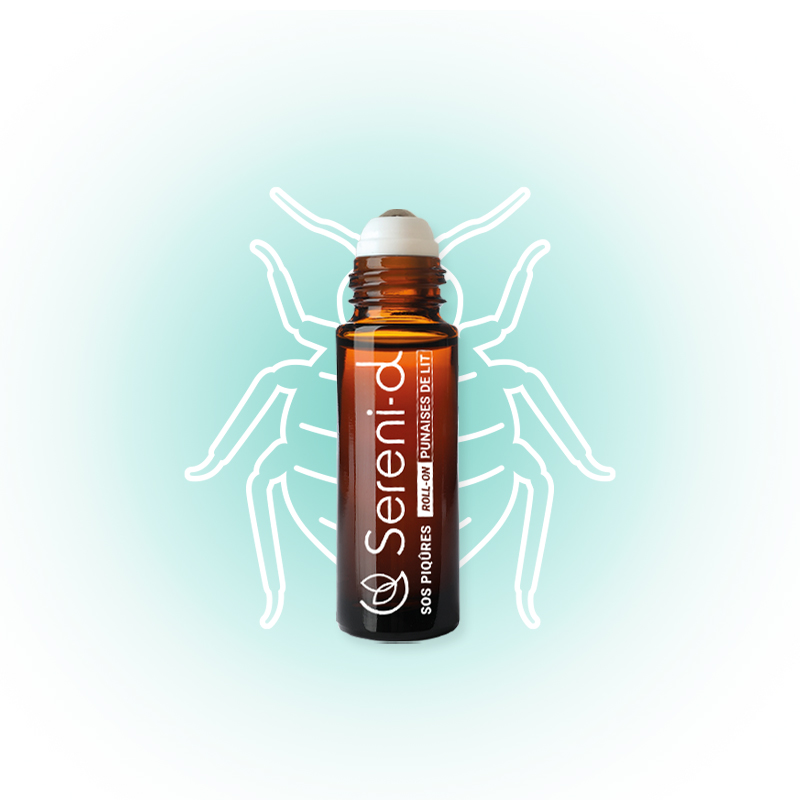
- Preventive and curative action
- Immediate and long-lasting effectiveness
- Antiseptic, soothing and regenerative properties
- Alcohol- and preservative-free
€14.90
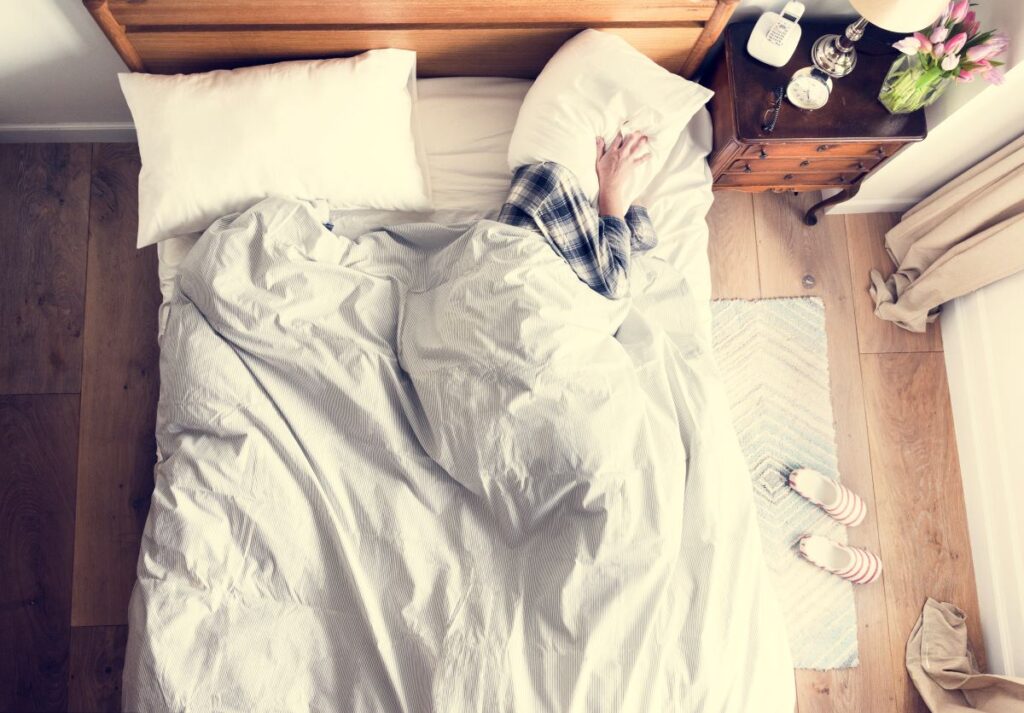
What are the consequences of a bedbug infestation?
A bedbug infestation in the home can have an impact on sleep. In fact, the presence of bedbugs in the home can cause psychological problems, with sleep difficulties and anxiety at the thought of being bitten during the night. The presence of bedbugs in the home is still very much frowned upon, even though this infestation is by no means due to a lack of hygiene.
There is no risk of transmitting a serious disease, but bedbug infestation can have psychological consequences that are often underestimated with sleep disorders, anxiety, post-traumatic syndromes linked to disinfection, and even social isolation in some cases. The French government has set up a support scheme to deal with bedbugs.
Causes and prevention of bedbugs
Here’s what attracts bedbugs and how to avoid bringing them home.
Causes: what attracts bedbugs? Where do bedbugs come from?
Bedbugs are attracted by heat, odours, vibrations and the carbon dioxide released by human breathing. Bedbugs have reappeared all over the world in recent years. In fact, travel encourages the movement of bedbugs. When travelling, it’s possible to bring bedbugs home without realizing it. They hide inside suitcases or on our clothes and infest our homes. Be sure to check the sheets and bedding when you’re away from home to prevent the spread of bedbugs. These parasites can live without food for weeks. Other causes of propagation: buying second-hand furniture and objects, or second-hand clothes that may be infested. When moving house, you should also check your new home before moving in.

Preventive treatment
Shield Bedbug Repellent
Sereni-d Shield Bedbug Repellent is a natural repellent treatment. Used as a preventive solution, it repels bedbugs for long-lasting, durable protection.
- Plant-based active ingredients and essential oil synergy blend
- NO synthetic permethrin, NO DEET, NO endocrine disruptors, NO flammable propellants
- Immediate and long-lasting effectiveness
€19.90
Preventive solutions to avoid bringing bedbugs home
To avoid infestation in your home, here are a few preventive tips:
- Do not put your suitcases on the floor or on the bed. Place them on a the luggage rack provided or in the bathroom, as bedbugs hate slippery surfaces such as tiles.
- As a preventive measure, use a bedbug repellent sprayed on clothing, bags and luggage. At Sereni-d, we have developed the Shield Preventive treatment against bedbugs. Made with plant pyrethrum flower extracts and essential oils, this natural repellent spray repels bedbugs. Its scent disturbs the olfactory receptors of bedbugs. It guarantees high preventive efficacy with an activity period of up to 7 days.
- You can also apply a body repellent to avoid bedbug bites, such as our Anti-Bedbug Spray. This body spray is a ready-to-use natural repellent that offers effective protection against bedbug bites. Anti-Bite Spray contains geraniol extract combined with a complex of essential and plant-based oils with repellent, moisturising and soothing properties.
Places frequently infested by bedbugs
Public places are frequently infested with bedbugs. They can be found in tourist establishments (hotels, Airbnb rooms, B&Bs, mountain refuges on GR footpaths, etc.), in places that welcome the public (dormitories, children’s day-care centres, sports halls, movie theaters, student housing, etc.).
Read our article on bedbugs in mountain refuges and how to prevent them.

FAQ
What do bed bugs look like?
Good to know: bed bugs can give off a characteristic odor when present in large numbers. This smell is often described as slightly sweet or musty, due to the pheromones they release.
➡️ Also worth reading: The appearance and life cycle of bed bugs.
Can you see bed bugs?
How do bed bugs appear?
The following are some of the causes of risk:
Travel: bed bugs can easily attach themselves to your luggage, bags or clothing after a stay in a hotel;
Second-hand purchases: second-hand bedding and clothing, etc. ;
Public transport: buses, trains, subways or planes;
Public places: infested cinemas, libraries, waiting rooms, shared offices, etc.
Hiking shelters;
Visiting relatives in infested homes.
How do I know if I have bed bugs?
Bites on the skin, which usually appear as small red spots, often grouped in lines or clusters on areas of skin exposed during sleep (arms, legs, neck, face).
Bloodstains on sheets: After feeding on blood, bed bugs can be accidentally crushed during the night, leaving small bloodstains on sheets or bed clothes.
Bed bug droppings: small black or brown spots, which are actually their excrement. These stains can be seen on sheets, mattresses, baseboards or furniture close to the bed. The stains are often embedded in fabrics and resemble small dots or ink marks.
Dead skin and eggs: As they grow, bed bugs moult several times. They leave behind small translucent skins that are visible to the naked eye. These molts are often found in the nooks and crannies of mattresses, under box springs or in cracks in furniture.
Musty or sweet smell: During a heavy infestation, you may detect a slight musty or sweet smell in the room. This smell comes from the pheromones released by bed bugs when they are present in large numbers.
Visible bed bugs: Although small, adult bed bugs can be visible to the naked eye.
Good to know: dog detection is an effective way of confirming the presence of bed bugs in your home.
How to prevent bed bugs?
Here are a few practical tips to prevent their appearance and limit the risk of infestation.
If you’re traveling, remember to inspect the bedding in your accommodation. Place your luggage on racks or suitcase holders rather than directly on the floor or bed. When you leave, inspect them. If in doubt, wash your clothes at high temperature and, if possible, vacuum or steam clean your suitcases.
Beware of second-hand furniture. When you buy it, be sure to inspect it thoroughly before taking it home.
Which product is most effective against bedbugs?
Our Serenid diatomaceous earth aerosol eliminates and prevents 100% of bed bugs (eggs, larvae, adults).
You can also use anti-bedbug covers for your bedding. Regularly change and wash your sheets, pillowcases and blankets at high temperature (at least 60°C) to eliminate any bed bugs.
You can also use bed bug traps placed under the foot of the bed to monitor their presence and prevent them from crawling back into the bedding. When traveling, the SHIELD will be your best ally in protecting your luggage from bed bugs.
Seal cracks and nooks in your home
Frequent cleaning, especially with a vacuum cleaner, helps eliminate potential eggs or bed bugs in carpets, furniture or hard-to-reach nooks and crannies.
➡️ To find out more, discover the complete bed bugs protocol.
What do bed bugs eat?
An adult bed bug generally feeds every 3 to 15 days (source), but can survive for several months without feeding if it doesn’t have access to a host.
During periods of dearth, they slow down their metabolism to save energy. A bed bug can survive for 18 months without feeding.
Do bed bugs fly?
Do bed bugs jump?
Bed bugs: should I throw away my mattress?
It’s better to treat the mattress than to throw it away.
To do this, you can :
Vacuum the mattress: dispose of the bag immediately, or empty the contents into an airtight bag to prevent the bedbugs from dispersing again.
Carry out a high-temperature treatment at at least 100°C (steam, dry heat);
Use specialized insecticides such as Serenid’s CRYO treatment to kill bed bugs and their eggs;
Use bed bugswith mattresscovers;
If you decide to dispose of the mattress, it’s important to do so properly to prevent bed bugs from spreading to other areas. Wrap the mattress in a thick plastic cover and seal it before removing it from your home. Mark it clearly as infested to prevent anyone else from picking it up.
How do I know if the bed bugs are gone?
Here are a few tips:
Keep an eye on your bites: If you don’t see any new bites for several weeks after treatment, that’s a very good sign;
Check old bedbug hiding places regularly;
Watch for suspicious marks and stains;
Make a second canine detection pass;
Reprogram a second pass if you’ve called in professional pest control services.
Good to know: After treatment, we recommend that you keep an eye on your home for at least 6 to 8 weeks.
Is it possible to carry bed bugs on your clothes?
Get rid of bedbugs, efficiently!
At the first sign of bedbugs, use our shock treatment SOS Bedbugs. Thanks to this plant-based insecticide spray composed of essential oils and pyrethrum flower, eliminate bedbugs at all stages of development: eggs, larvae and adults.
Ideal for immediate, safe, long-lasting protection!

